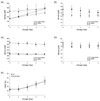Effect of storage on levels of nitric oxide metabolites in platelet preparations
- PMID: 22804724
- PMCID: PMC3548060
- DOI: 10.1111/j.1537-2995.2012.03777.x
Effect of storage on levels of nitric oxide metabolites in platelet preparations
Abstract
Background: Nitric oxide (NO), a potent signaling molecule, is known to inhibit platelet (PLT) function in vivo. We investigated how the levels of NO and its metabolites change during routine PLT storage. We also tested whether the material of PLT storage containers affects nitrite content since many plastic materials are known to contain and release nitrite.
Study design and methods: For nitrite and nitrate measurement, leukoreduced apheresis PLTs and concurrent plasma (CP) were collected from healthy donors using a cell separator. Sixty-milliliter aliquots of PLT or CP were stored in CLX or PL120 Teflon containers at 20 to 24°C with agitation and daily samples were processed to yield PLT pellet and supernatant. In a separate experiment, PLTs were stored in PL120 Teflon to measure NO generation using electron paramagnetic resonance (EPR).
Results: Nitrite level increased markedly in both PLT supernatant and CP stored in CLX containers at a rate of 58 and 31 nmol/L/day, respectively. However, there was a decrease in nitrite level in PLTs stored in PL120 Teflon containers. Nitrite was found to leach from CLX containers and this appears to compensate for nitrite consumption in these preparations. Nitrate level did not significantly change during storage.
Conclusion: PLTs stored at 20 to 24°C maintain measurable levels of nitrite and nitrate. The nitrite decline in nonleachable Teflon containers in contrast to increases in CLX containers that leach nitrite suggests that it is consumed by PLTs, residual white blood cells, or red blood cells. These results suggest NO-related metabolic changes occur in PLT units during storage.
© 2012 American Association of Blood Banks.
Conflict of interest statement
Figures



References
-
- Ignarro LJ, Byrns RE, Buga GM, Wood KS. Endothelium-derived relaxing factor from pulmonary artery and vein possesses pharmacologic and chemical properties identical to those of nitric oxide radical. Circ Res. 1987;61:866–879. - PubMed
-
- Palmer RM, Ferrige AG, Moncada S. Nitric oxide release accounts for the biological activity of endothelium-derived relaxing factor. Nature. 1987;327:524–526. - PubMed
-
- Palmer RM, Ashton DS, Moncada S. Vascular endothelial cells synthesize nitric oxide from L-arginine. Nature. 1988;333:664–666. - PubMed
-
- Gkaliagkousi E, Ferro A. Nitric oxide signalling in the regulation of cardiovascular and platelet function. Front Biosci. 2011;16:1873–1897. - PubMed
Publication types
MeSH terms
Substances
Grants and funding
LinkOut - more resources
Full Text Sources
Medical
Miscellaneous

